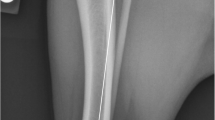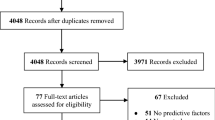Abstract
Introduction
Acute extremity compartment syndrome (“CS”) is an under-researched, highly morbid condition affecting trauma populations. The purpose of this study was to analyze incidence rates and risk factors for extremity compartment syndrome using a high-quality population database. Additionally, we evaluated heritable risk for CS using available genealogic data. We hypothesized that diagnosis of extremity compartment syndrome would demonstrate heritability.
Materials and methods
Adult patients with fractures of the tibia, femur, and upper extremity were retrospectively identified by ICD-9, ICD-10, and CPT codes from 1996 to 2020 in a statewide hospital database. Exposed and unexposed cohorts were created based on a diagnosis of CS. Available demographic data were analyzed to determine risk factors for compartment syndrome using logistic regression. Mortality risk at the final follow-up was evaluated using Cox proportional hazard modeling. Patients with a diagnosis of CS were matched with those without a diagnosis for heritability analysis.
Results
Of 158,624 fractures, 931 patients were diagnosed with CS. Incidence of CS was 0.59% (tibia 0.83%, femur 0.31%, upper extremity 0.27%). Male sex (78.1% vs. 46.4%; p < 0.001; RR = 3.24), younger age at fracture (38.8 vs. 48.0 years; p < 0.001; RR = 0.74), Medicaid enrollment (13.2% vs. 9.3%; p < 0.001; RR = 1.58), and smoking (41.1% vs. 31.1%; p < 0.001; RR 1.67) were significant risk factors for CS. CS was associated with mortality (RR 1.61, p < 0.001) at mean follow-up 8.9 years in the CS cohort. No significant heritable risk was found for diagnosis of CS.
Conclusions
Without isolating high-risk fractures, rates of CS are lower than previously reported in the literature. Male sex, younger age, smoking, and Medicaid enrollment were independent risk factors for CS. CS increased mortality risk at long-term follow-up. No heritable risk was found for CS.
Level of evidence
III.

Similar content being viewed by others
Data availability
Data may be available by request.
References
Anders M, Mutty C, Cornwall A (2016) Geographic variation in fasciotomy during operative management of tibia fractures. J Orthop 13(3):225–229
Anderson MB, Curtin K, Wong J, Pelt CE, Peters CL, Gililland JM (2017) Familial clustering identified in periprosthetic joint infection following primary total joint arthroplasty: a population-based cohort study. J Bone Jt Surg Am 99(11):905–913
Auld TS, Hwang JS, Stekas N et al (2017) The correlation between the OTA/AO classification system and compartment syndrome in both bone forearm fractures. J Orthop Trauma 31(11):606–609
Bhattacharyya T, Vrahas MS (2004) The medical-legal aspects of compartment syndrome. J Bone Jt Surg Am 86(4):864–868
Blair JA, Stoops TK, Doarn MC et al (2016) Infection and nonunion after fasciotomy for compartment syndrome associated with tibia fractures: a matched cohort comparison. J Orthop Trauma 30(7):392–396
Branco BC, Inaba K, Barmparas G et al (2011) Incidence and predictors for the need for fasciotomy after extremity trauma: a 10-year review in a mature level I trauma centre. Injury 42(10):1157–1163
Crespo AM, Manoli A 3rd, Konda SR, Egol KA (2015) Development of compartment syndrome negatively impacts length of stay and cost after tibia fracture. J Orthop Trauma 29(7):312–315
Deng X, Hu H, Ye Z, Zhu J, Zhang Y, Zhang Y (2021) Predictors of acute compartment syndrome of the lower leg in adults following tibial plateau fractures. J Orthop Surg Res 16(1):502
Heppenstall RB, Sapega AA, Izant T et al (1989) Compartment syndrome: a quantitative study of high-energy phosphorus compounds using 31P-magnetic resonance spectroscopy. J Trauma 29(8):1113–1119
Kazmers NH, Meeks HD, Novak KA et al (2021) Familial clustering of erosive hand osteoarthritis in a large statewide cohort. Arthritis Rheumatol 73(3):440–447
Kazmers NH, Yu Z, Barker T, Abraham T, Romero R, Jurynec MJ (2020) Evaluation for Kienbock disease familial clustering: a population-based cohort study. J Hand Surg Am 45(1):1 e1-8 e1
Kerber RA, O’Brien E (2005) A cohort study of cancer risk in relation to family histories of cancer in the Utah population database. Cancer 103(9):1906–1915
Koleszar JC, Childs BR, Vallier HA (2016) Frequency of recidivism in patients with orthopedic trauma. Orthopedics 39(5):300–306
Marchand LS, Working ZM, Rane AA et al (2020) Compartment syndrome in tibial plateau fractures: do previously established predictors have external validity? J Orthop Trauma 34(5):238–243
Matsen FA 3rd, Winquist RA, Krugmire RB Jr (1980) Diagnosis and management of compartmental syndromes. J Bone Jt Surg Am 62(2):286–291
McQueen MM, Court-Brown CM (1996) Compartment monitoring in tibial fractures. The pressure threshold for decompression. J Bone Jt Surg Br 78(1):99–104
McQueen MM, Duckworth AD, Aitken SA, Sharma RA, Court-Brown CM (2015) Predictors of compartment syndrome after tibial fracture. J Orthop Trauma 29(10):451–455
McQueen MM, Gaston P, Court-Brown CM (2000) Acute compartment syndrome. Who is at risk? J Bone Jt Surg Br 82(2):200–203
Meskey T, Hardcastle J, O’Toole RV (2011) Are certain fractures at increased risk for compartment syndrome after civilian ballistic injury? J Trauma 71(5):1385–1389
O’Neill DC, Boes EA, McCutcheon C, Haller JM (2022) Animal models in compartment syndrome: a review of existing literature. OTA Int 5(1 Suppl):e163
O’Toole RV, Whitney A, Merchant N et al (2009) Variation in diagnosis of compartment syndrome by surgeons treating tibial shaft fractures. J Trauma 67(4):735–741
Osborn CPM, Schmidt AH (2020) Management of acute compartment syndrome. J Am Acad Orthop Surg 28(3):e108–e114
Prayson MJ, Chen JL, Hampers D, Vogt M, Fenwick J, Meredick R (2006) Baseline compartment pressure measurements in isolated lower extremity fractures without clinical compartment syndrome. J Trauma 60(5):1037–1040
Ruffolo MR, Gettys FK, Montijo HE, Seymour RB, Karunakar MA (2015) Complications of high-energy bicondylar tibial plateau fractures treated with dual plating through 2 incisions. J Orthop Trauma 29(2):85–90
Saiz AM Jr, Wellman AC, Stwalley D, Wolinsky P, Miller AN (2020) The incidence and risk factors associated with the need for fasciotomy in tibia and forearm fractures: an analysis of the National Trauma Data Bank. J Orthop Trauma 34(5):e154–e158
Schmidt AH, Di J, Zipunnikov V et al (2020) Perfusion pressure lacks diagnostic specificity for the diagnosis of acute compartment syndrome. J Orthop Trauma 34(6):287–293
Smolle MA, Petermeier V, Ornig M et al (2022) A nomogram predicting risk for acute compartment syndrome following tibial plateau fractures. Single centre retrospective study. Injury 53(2):669–675
Spiker WR, Brodke DS, Goz V, Lawrence B, Teerlink CC, Cannon-Albright LA (2018) Evidence of an inherited predisposition for spinal cord tumors. Glob Spine J 8(4):340–344
Ulmer T (2002) The clinical diagnosis of compartment syndrome of the lower leg: are clinical findings predictive of the disorder? J Orthop Trauma 16(8):572–577
White TO, Howell GE, Will EM, Court-Brown CM, McQueen MM (2003) Elevated intramuscular compartment pressures do not influence outcome after tibial fracture. J Trauma 55(6):1133–1138
Williams RL (2000) A note on robust variance estimation for cluster-correlated data. Biometrics 56(2):645–646
Ziran BH, Becher SJ (2013) Radiographic predictors of compartment syndrome in tibial plateau fractures. J Orthop Trauma 27(11):612–615
Acknowledgements
We thank the Pedigree and Population Resource of Huntsman Cancer Institute, University of Utah (funded in part by the Huntsman Cancer Foundation) for its role in the ongoing collection, maintenance, and support of the Utah Population Database (UPDB). We also acknowledge partial support for the UPDB through grant P30 CA2014 from the National Cancer Institute, University of Utah and from the University of Utah’s program in Personalized Health and Center for Clinical and Translational Science. Research was supported by the NCRR grant, “Sharing Statewide Health Data for Genetic Research” (R01 RR021746, G. Mineau, PI) with additional support from the Utah Department of Health and the University of Utah.
Author information
Authors and Affiliations
Contributions
DO’, LS, LM, and AK contributed to study design, literature review, research approvals, and manuscript writing for this study. HM and AF contributed data collection and statistical analysis. LM and JH contributed to study design and critical revision.
Corresponding author
Ethics declarations
Conflict of interest
Dillon O’Neill, Lillia Steffenson, Luke Myhre, Adam Kantor, Huong Meeks, Alison Fraser, and Lucas Marchand have no conflicts of interest to declare. Justin Haller is a paid consultant for NewClip Technics, Orthogrid, Osteocentric, and Stryker. He is a board member of the Orthopaedic Trauma Association and the Western Orthopedic Association.
Additional information
Publisher's Note
Springer Nature remains neutral with regard to jurisdictional claims in published maps and institutional affiliations.
Supplementary Information
Below is the link to the electronic supplementary material.
Rights and permissions
Springer Nature or its licensor (e.g. a society or other partner) holds exclusive rights to this article under a publishing agreement with the author(s) or other rightsholder(s); author self-archiving of the accepted manuscript version of this article is solely governed by the terms of such publishing agreement and applicable law.
About this article
Cite this article
O’Neill, D.C., Steffenson, L.N., Myhre, L.A. et al. Analysis of acute extremity compartment syndrome using a genealogic population database. Arch Orthop Trauma Surg 144, 149–160 (2024). https://doi.org/10.1007/s00402-023-05074-8
Received:
Accepted:
Published:
Issue Date:
DOI: https://doi.org/10.1007/s00402-023-05074-8




